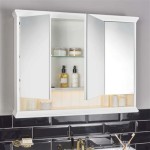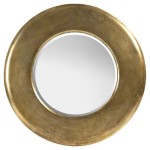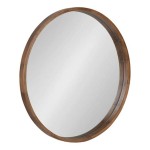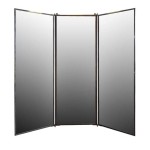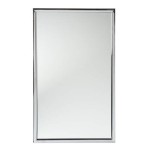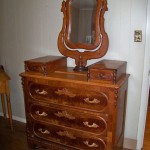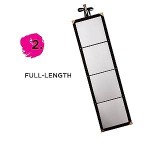Antique Victorian Hall Tree With Mirror
The Victorian era, spanning the reign of Queen Victoria from 1837 to 1901, witnessed a flourishing of decorative arts. Among the many furniture pieces characteristic of this period, the hall tree with mirror stands out as both functional and aesthetically significant. These imposing pieces, typically placed in the entryway or hallway, served as a practical solution for storing outerwear and accessories while simultaneously enhancing the home's decor.
Design and Construction
Victorian hall trees were typically constructed from solid wood, often walnut, mahogany, or oak. Carving, intricate turnings, and decorative inlay work were common features. The central structure usually consisted of a robust, freestanding frame, often with a lower cabinet or drawer for storing shoes and other items. Extending upwards from this base was a coat rack with multiple hooks or pegs, often ornamented with decorative finials or carvings. Surmounting the structure was a beveled mirror, sometimes framed with elaborate woodwork or decorative elements like inlaid tiles or etched glass.
Reflecting Victorian Sensibilities
The hall tree reflects many key characteristics of Victorian design. The emphasis on ornate details, dark wood finishes, and the overall imposing presence of the piece speak to the era's focus on grandeur and elaborate craftsmanship. The incorporation of a mirror was not merely functional; it served to amplify light and space within the hallway, a key consideration in Victorian homes. Furthermore, the mirror allowed for a final check of one's appearance before venturing out, reflecting the Victorian preoccupation with social decorum and presentation.
Variations and Styles
The Victorian era encompassed a range of styles, from the early Gothic Revival to the later Aesthetic Movement, and these influences are reflected in the diverse designs of hall trees. Some hall trees incorporated elements of Gothic architecture, such as pointed arches and intricate tracery, while others embraced the natural forms and flowing lines of the Art Nouveau style. Some simpler, more utilitarian designs were produced, reflecting the Arts and Crafts movement's emphasis on honest craftsmanship and functional design. The variety in styles ensures that antique Victorian hall trees can complement a range of interior design schemes.
The Mirror as a Focal Point
The mirror itself is often a defining characteristic of the Victorian hall tree. The size and shape of the mirror varied considerably, from small oval or rectangular shapes to large, imposing designs that dominated the piece. Beveled edges were a common feature, adding depth and refracting light to create a sparkling effect. Some mirrors were etched with decorative patterns or adorned with gilded frames, contributing to the overall opulence of the piece.
Practicality and Functionality
Beyond their aesthetic appeal, Victorian hall trees served an essential practical purpose. They provided a designated space for storing outerwear, hats, umbrellas, and other accessories, keeping the entryway organized and clutter-free. The lower cabinet or drawer provided additional storage for shoes and other items, promoting tidiness in an era when domestic order was highly valued.
Identifying and Evaluating Antique Victorian Hall Trees
When evaluating an antique Victorian hall tree, several factors should be considered. The quality of the wood, the intricacy of the carving and other decorative details, and the overall condition of the piece are key indicators of its value. Examining the construction techniques, such as joinery and the use of hand-carved elements versus machine-made components, can help determine the age and authenticity of the piece. The presence of a maker's mark can also provide valuable information about the piece's provenance.
The Hall Tree in Contemporary Interiors
Despite being remnants of a bygone era, antique Victorian hall trees continue to be sought-after pieces for contemporary interiors. Their timeless elegance and practical functionality make them a versatile addition to a variety of design schemes. They can serve as a striking focal point in a modern entryway or add a touch of vintage charm to a more traditional setting. Their enduring appeal speaks to the quality of craftsmanship and timeless design that characterizes the best of Victorian furniture.
Restoration and Care
Proper care and restoration can help preserve antique Victorian hall trees for generations to come. Regular dusting and polishing with appropriate wood care products can help maintain the finish and prevent damage. Repairs to damaged areas should be undertaken by experienced professionals to ensure the piece's integrity and value are preserved. Avoiding placing the hall tree in direct sunlight or excessively humid environments can help prevent fading and warping of the wood and damage to the mirror. By taking appropriate care, these beautiful and functional pieces can continue to be enjoyed for years to come.

Antique Hall Tree With Mirror Oddities Curiosities Crafts And More We Must B Oak Furniture Vintage

19th Century Eastlake Victorian Hall Tree

Carved Oak Hall Tree With Shaped Beveled Mirror Wooden Nickel Antiques

Antique Large Oak Hall Tree Bench W Mirror Excellent Condition Long Valley Traders

Antique Hall Tree Coat Rack Mirror Garment Closet Entry

Antique Victorian Large Entry Hall Mirror Tree Dressing

Large Walnut Hall Tree With Wolf Carving Mirror Wooden Nickel Antiques

Victorian Carved Oak Hall Tree Coat Hat Stand With Mirror And

19th Century Victorian Hall Tree Trees Antique

Antique Eastlake Victorian Hall Tree Halltree Stand Carved Ornate Mirror Walnut

